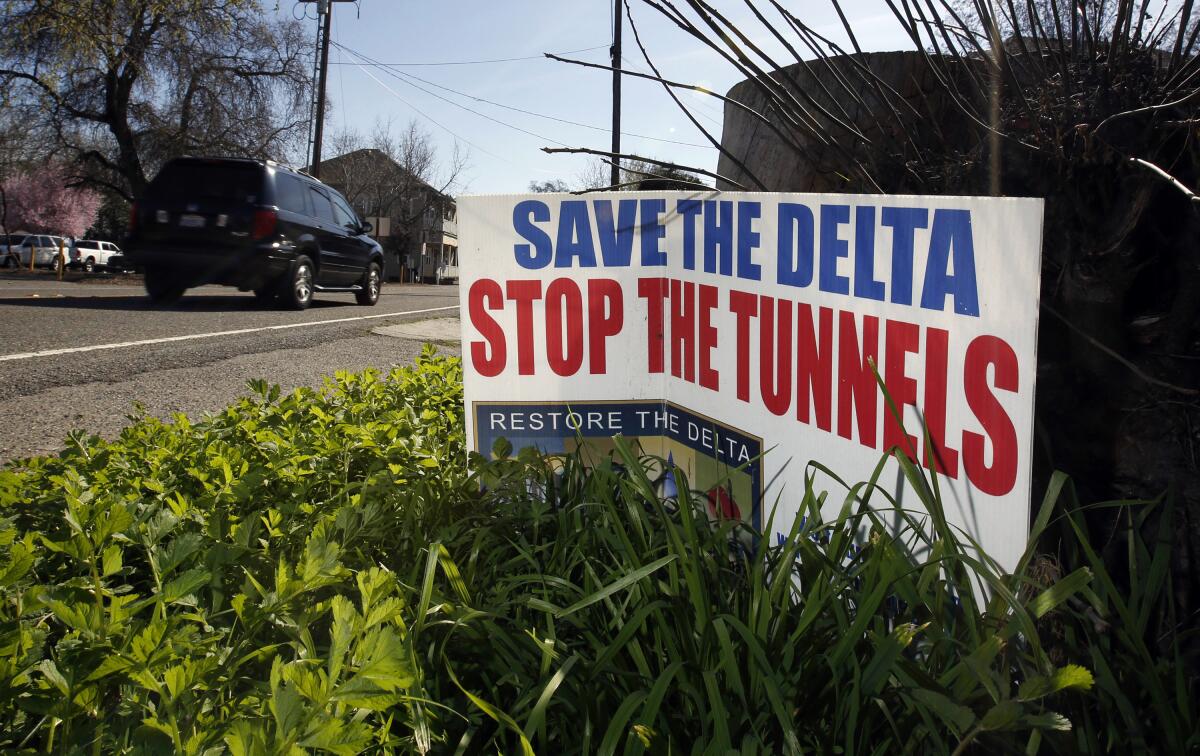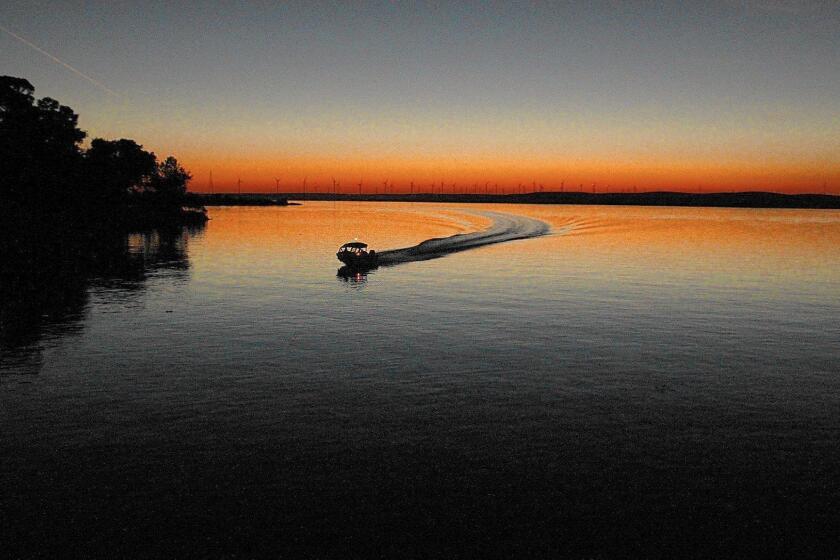Report urges Metropolitan Water District to abandon Newsom’s $16-billion delta tunnel plan

- Share via
Gov. Gavin Newsom and his administration have touted plans to build a tunnel to transport water beneath the Sacramento-San Joaquin River Delta, saying the project would modernize California’s water infrastructure and help the state adapt to climate change.
But an advocacy group is urging the Metropolitan Water District of Southern California to abandon the $16-billion project, saying it doesn’t make financial sense for the state’s largest urban water agency.
In a report released this week, the California Water Impact Network said the delta tunnel may seem like a viable alternative but has three major flaws: “an exorbitant price tag, environmental restrictions on operations and the impacts of climate change on deliveries.”
“This is a critical decision point,” said Max Gomberg, a former State Water Resources Control Board staffer who wrote the report and has criticized the Newsom administration.
Gomberg said if the MWD board agrees to support the delta tunnel project and take on its portion of the cost, “that is going to really impact the cost of water and ultimately ratepayer bills.”
Smaller than previous versions, the project is still huge, and is sure to be litigated by environmental groups and Sacramento-San Joaquin farmers.
The Metropolitan Water District imports water from the delta and the Colorado River and delivers it to cities and water agencies that supply about 19 million people across Southern California.
Gomberg recommended that the MWD produce detailed cost estimates that incorporate changing hydrologic conditions and that it analyze implications on the affordability of water for all ratepayers.
Instead of supporting the delta project, he said, the MWD should study investments in local projects, such as infrastructure to capture stormwater, clean up contaminated groundwater and recycle wastewater.
Gomberg said that while proponents tout the project as a way to make water supplies more reliable, “the promised reliability is highly uncertain” given the effects of climate change and environmental regulations that restrict pumping.
The Newsom administration last year released plans for the proposed tunnel, which would capture water from the Sacramento River and transport it for miles under the delta. The water would reach existing pumps that send it south through the aqueducts of the State Water Project, flowing toward farmlands and Southern California’s cities.
Over the past two decades, the MWD has spent about $240 million on planning for iterations of the proposed tunnel. The agency’s 38-member board has yet to take a vote on whether to support the so-called Delta Conveyance Project. The earliest such a vote could be held is late 2024, but a decision could be delayed further.
“They’ve spent a lot of money on studies for the delta project,” Gomberg said during a news conference Tuesday. “They could cut that out of their budget, and that would be significant cost savings.”
Gomberg, who resigned last year from the State Water Resources Control Board, citing disagreements with the Newsom administration, now works with the California Water Impact Network as a consultant.
A state water board official has resigned, claiming the Newsom administration has “nearly eviscerated” the board’s ability to confront drought.
Adán Ortega Jr., chair of the MWD board, said Gomberg has been asked to speak to the agency’s staff about his report. The agency will probably ask him to brief a committee that is working on a climate change adaptation plan.
“I think the board needs to understand from a variety of perspectives where the risks are in our delta investments,” Ortega said in an interview. “I think Metropolitan is looking at the delta with its eyes open. I think this report points to a lot of things that people are thinking about, and I’m glad that it’s there to inform the board as we look at our long-term climate adaptation planning.”
Ortega said he agrees with some points raised in the report, and “they’re relevant to this discussion that we have to have.”
“I think we’ve spent way too much in the delta in general,” Ortega added. “Imagine what we could have built down here with that.”
The district, he noted, is working on planning a large wastewater recycling project in Southern California.
Ortega cited the many years of conflicts over versions of the delta project, including a two-tunnel proposal under former Gov. Jerry Brown, as well as other water-related decisions in the delta.
“The same thing is happening with respect to the single tunnel, in terms of the challenges against it, that were happening against the dual tunnel,” Ortega said. “If you look at the history of these bay delta discussions, it’s litigation after litigation, challenge after challenge — on the permits, on everything.
“From what I’ve been told by staff here, we’re not going to be building any delta conveyance within this next planning horizon. Our planning horizon is 25 years,” he said.
Ortega said he is assuming that during his tenure as chair, the project will stay “in the background, simply because of the litigious and challenging history of it.” He said when asked if he is in favor of the project, his response is, “This debate is impractical.”
“It’s not doing the delta any good, because it prevents the long-term planning that needs to take place there,” Ortega said. “I want to see some analysis of the climate change impacts in the delta.”
California officials are touting a $2.6-billion deal to boost the health of a vital watershed, but environmentalists are calling it a backroom scheme.
Others argue that California needs the project. Water managers have said building it would help ensure that the State Water Project can more reliably capture and move water.
The Department of Water Resources said recently that if the project had been operational during the storms in January, it would have been able to send much more water south toward San Luis Reservoir “while still meeting fishery and water quality protections and regulations.”
The project is “is essential to maintain reliable water supplies, particularly as we deal with more prolonged droughts and periods of intense flooding,” said Nicolette Velazquez, a spokesperson for Californians for Water Security.
Gomberg disagreed, saying that during dry conditions, environmental restrictions reduce the amount of water that can be pumped.
“These restrictions are going to be there. And the so-called reliability of this project is not,” Gomberg said.
Gomberg said the MWD needs to “reevaluate its business model.” He pointed out that the district is a wholesaler of imported water, and the vast majority of its revenue comes from selling water. But those sales have declined in recent years as residents have continued to conserve, bringing down the region’s water footprint.
“As those water sales decline, that is going to put an increasing strain on Met’s budget and create a set of difficult economic decisions about whether to try to increase revenues by increasing prices, diversify the revenue stream, cut expenses — but something has to give,” Gomberg said. “Otherwise, the financial position for Met and the affordability issues for the customers, households in Southern California, are going to be increasingly dire.”
He suggested that as a large landowner, the MWD could generate revenue by leasing land to put up solar panels or install telecommunications equipment.
As the district’s officials work on developing a climate adaptation plan in the coming months, they are preparing for expected cuts in supplies from the Colorado River. The river’s reservoirs have been severely depleted during 23 years of drought worsened by global warming, and the federal government is considering options for preventing reservoirs from falling to critically low levels.
The district’s managers have increasingly focused on plans to invest in local projects, such as recycling wastewater, to become less reliant on imported water.
“What we really need to do is figure out our business model so that we could sustain the enormous cost of building the local projects that we all want to build,” Ortega said. “I think the region recognizes that we have some huge challenges in building up our local resiliency.”










